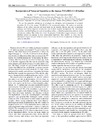Identificador persistente para citar o vincular este elemento:
https://accedacris.ulpgc.es/jspui/handle/10553/73182
| Campo DC | Valor | idioma |
|---|---|---|
| dc.contributor.author | Lee, Jun Hee | en_US |
| dc.contributor.author | Fernandez Hevia, Daniel | en_US |
| dc.contributor.author | Selloni, Annabella | en_US |
| dc.date.accessioned | 2020-06-10T11:50:35Z | - |
| dc.date.available | 2020-06-10T11:50:35Z | - |
| dc.date.issued | 2013 | en_US |
| dc.identifier.issn | 0031-9007 | en_US |
| dc.identifier.other | WoS | - |
| dc.identifier.other | Scopus | - |
| dc.identifier.uri | https://accedacris.ulpgc.es/handle/10553/73182 | - |
| dc.description.abstract | We use first principles calculations to investigate the adsorption and incorporation of nonmetal impurities ( N, C) at the anatase TiO2(001)-(1 x 4) reconstructed surface. We analyze in detail the influence of the surface structure and local strain on the impurity binding sites and incorporation pathways and identify important intermediates that facilitate impurity incorporation. We find various subsurface interstitial binding sites and corresponding surface -> subsurface penetration pathways on the reconstructed surface. This surface also favors the presence of subsurface oxygen vacancies, to which adsorbed species can migrate to form substitutional impurities. Most notably, we show that the nonexposed oxygen sites just below the surface have a key role in the incorporation of nitrogen and carbon in TiO2(001). | en_US |
| dc.language | eng | en_US |
| dc.relation.ispartof | Physical Review Letters | en_US |
| dc.source | Physical Review Letters [ISSN 0031-9007], v. 110 (1), (Enero 2013) | en_US |
| dc.subject | 2307 Química física | en_US |
| dc.subject.other | Visible-Light Photocatalysis | en_US |
| dc.subject.other | Titanium-Dioxide | en_US |
| dc.subject.other | Tio2 Photocatalysis | en_US |
| dc.subject.other | Doped Tio2 | en_US |
| dc.subject.other | Science | en_US |
| dc.title | Incorporation of nonmetal impurities at the anatase TiO2(001)- (1×4) surface | en_US |
| dc.type | info:eu-repo/semantics/Article | en_US |
| dc.type | Article | en_US |
| dc.identifier.doi | 10.1103/PhysRevLett.110.016101 | en_US |
| dc.identifier.scopus | 84871818819 | - |
| dc.identifier.isi | 000313006100034 | - |
| dc.contributor.authorscopusid | 56493776300 | - |
| dc.contributor.authorscopusid | 36793606200 | - |
| dc.contributor.authorscopusid | 7005934221 | - |
| dc.identifier.eissn | 1079-7114 | - |
| dc.identifier.issue | 1 | - |
| dc.relation.volume | 110 | en_US |
| dc.investigacion | Ciencias | en_US |
| dc.type2 | Artículo | en_US |
| dc.contributor.daisngid | 2744312 | - |
| dc.contributor.daisngid | 3261521 | - |
| dc.contributor.daisngid | 54301 | - |
| dc.description.numberofpages | 5 | en_US |
| dc.utils.revision | Sí | en_US |
| dc.contributor.wosstandard | WOS:Lee, JH | - |
| dc.contributor.wosstandard | WOS:Hevia, DF | - |
| dc.contributor.wosstandard | WOS:Selloni, A | - |
| dc.date.coverdate | Enero 2013 | en_US |
| dc.identifier.ulpgc | Sí | es |
| dc.description.sjr | 5,674 | |
| dc.description.jcr | 7,728 | |
| dc.description.sjrq | Q1 | |
| dc.description.jcrq | Q1 | |
| dc.description.scie | SCIE | |
| item.fulltext | Con texto completo | - |
| item.grantfulltext | open | - |
| Colección: | Artículos | |
Citas SCOPUSTM
27
actualizado el 08-jun-2025
Citas de WEB OF SCIENCETM
Citations
24
actualizado el 08-jun-2025
Visitas
63
actualizado el 31-may-2025
Descargas
36
actualizado el 31-may-2025
Google ScholarTM
Verifica
Altmetric
Comparte
Exporta metadatos
Los elementos en ULPGC accedaCRIS están protegidos por derechos de autor con todos los derechos reservados, a menos que se indique lo contrario.
